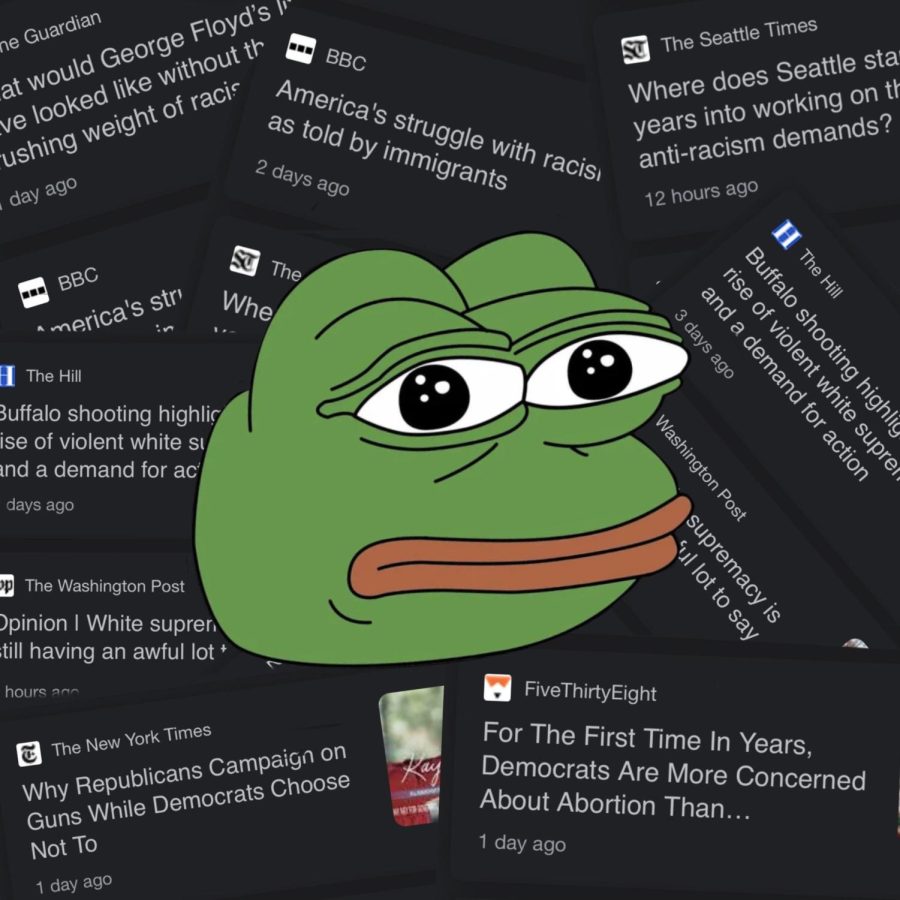Opinion: It’s Not Just a Joke
Memes have formed both shields and pipelines into fascistic ideology, coaxing a myriad of internet users into its ranks.
False irony has allowed a new wave of fascism to infiltrate the internet.
May 31, 2022
With the growth of the internet has come a new wave of fascism, a phenomenon that has been noted by journalists, YouTube personalities, and authors alike. The increasing popularity of online authoritarian nationalism, often called the alternative right or the “alt-right,” has risen to a terrifying degree, eclipsing online spheres and breaking into real life. The pervasive racist, anti-Semitic, and sexist ideology that underlines the January 6th attack on the Capitol particularly comes to mind. From the Oath Breakers to the Proud Boys, noted fascist groups came out in droves, a shocking wake-up call to many Americans.
The alternative right has been a continual presence within politics, but the internet has fed new life into the movement, particularly in the form of memes. Its online origins begin near the conception of the internet with anonymous message boards like 4chan. The anonymity of 4chan allowed many people to speak without consequence, and the website soon became known as a board for “transgressive” ideology that sought to break taboo, especially in cultural attitudes surrounding race and gender.
Predictably, this attitude brought with it a wave of fascism, which branched into other social media platforms as the internet grew in size and ubiquity. Memes like Pepe and Doge grew into vehicles for alt-right, as well as the use of “irony” and “satire” for plausible deniability in repeating alt-right messaging.
In 2017, a report by Data & Society Institute studied the use of memes and irony within far-right circles. Dr. Alice Marwick, the co-author of the 2017 report, said, “Irony has a strategic function. It allows people to disclaim a real commitment to far-right ideas while still espousing them.”
Often, memes of how progressives and members of the media view conservatives are used as vehicles of fascistic messaging. If you attack a meme for being bigoted, then you are shot down and called naïve for falling for it. If you ignore it, then you are glossing over what can and will pose a real threat in the growth of the alt-right. And most dangerously, if you laugh along, you could very well be pulled in from memes to ideology.
Ryan Milner, who teaches Communication at the College of Charleston and co-authored The Ambivalent Internet, said, “Unless you have an obvious marker of another person’s intent, you can’t really gauge their intent. They could be messing around. They could be deadly serious. They could be a mix of both.”
The use of irony as plausible deniability has, over the years, permeated into real life as well. In 2016, when Richard Spencer led a Nazi salute to Donald Trump at his National Policy Institute conference, he said it was “clearly done in a spirit of irony and exuberance”. If an action as blatant as a Nazi salute can be defended like this, it raises the question: just how much can we brush off as irony?
The alt-right has fashioned humor into a weapon to both promote their ideology and masquerade it. As Marwick stated, “Irony allows people to strategically distance themselves from the very real commitment to white supremacist values that many of these forums have.”
The algorithms of the internet only further the reach of the alt-right, targeting young white men in particular. In 2021, the Anti-Defamation League released a report that found that 17 percent of 13-to-17-year-olds encounter white-supremacist views on social media. TikTok, and YouTube before it, have had a large hand in influencing the politics of its users.
The algorithms of social media do not point in a particular direction. They are not built to promote a particular ideology; they are built to create customers. Social media algorithms are designed to keep users on the app and generate profit, and in doing so, they offer rabbit holes. One of the biggest rabbit holes just happens to be alt-right creators.
The alt-right pipeline is often credited to YouTube, and in 2021, Harvard journalist Aidan Scully outlined his personal experience with the pipeline. The YouTube algorithm recommends the videos that constitute 70 percent of the time spent on the site, and Scully notes that each video recommended to him was “more aggressive than the last.”
The alt-right pipeline is particularly attractive to young white men, especially those who feel depressed. It offers simple solutions and people to blame for a failing economy, a new age of struggles for change, and a turbulent world full of polarization. It should not be surprising that the ADL study found that an estimated 2.3 million teens are exposed to white-supremacist ideology in chats for multiplayer games like World of Warcraft, Fortnite, Apex Legends, League of Legends, Madden, Overwatch, and Call of Duty each year. This is messaging that appeals to young white men in spaces where they are more concentrated.
But the pipeline is as isolating as it is accepting of these young men.
“I began to see the world the way those commentators saw it,” Scully wrote. “I felt threatened where there was no threat, attacked where there was no attacker, and defensive of this new identity I had been given, an identity I had never wanted to have. The world I experienced and the world I saw were fundamentally disconnected.”
So how can we fix this?
It isn’t simply a matter of memorizing lists of memes often used as ideological pipelines. After all, memes are so easily shared that those repeating fascist ideology are often shared unconsciously and ignorantly, and internet trends shift so quickly that by the time we identify one meme as fascistic, a new one has already formed.
As Angela Nagle, author of Kill All Normies: From 4chan and Tumblr to Trump and the Alt-Right, said, “Journalists should be saying, ‘I don’t want to talk about Pepe memes and hand signs. Tell me what are the limits of what you’re prepared to do.’ We should force them to talk about what they really stand for.”
In his article, author Ibram X. Kendi emphasizes traditional education in combating the alt-right. It should be noted that learning about the alt-right, especially in the context of the internet, cannot simply be about talking points and history. One must learn about ideology and the ability to identify it, even when cloaked in irony.
As the internet grows, we must also question the algorithms that feed people into the pipeline. If this is what a focus on profit has led to, then there must be another direction we can point our algorithms to.
Scully gives hope on helping a future generation out of the pipeline, writing, “[I]t must be acknowledged that the alt-right pipeline doesn’t lead anywhere: It just keeps descending. And while that means it will become harder and harder to address with time, it also means no one is ever too far gone.”














